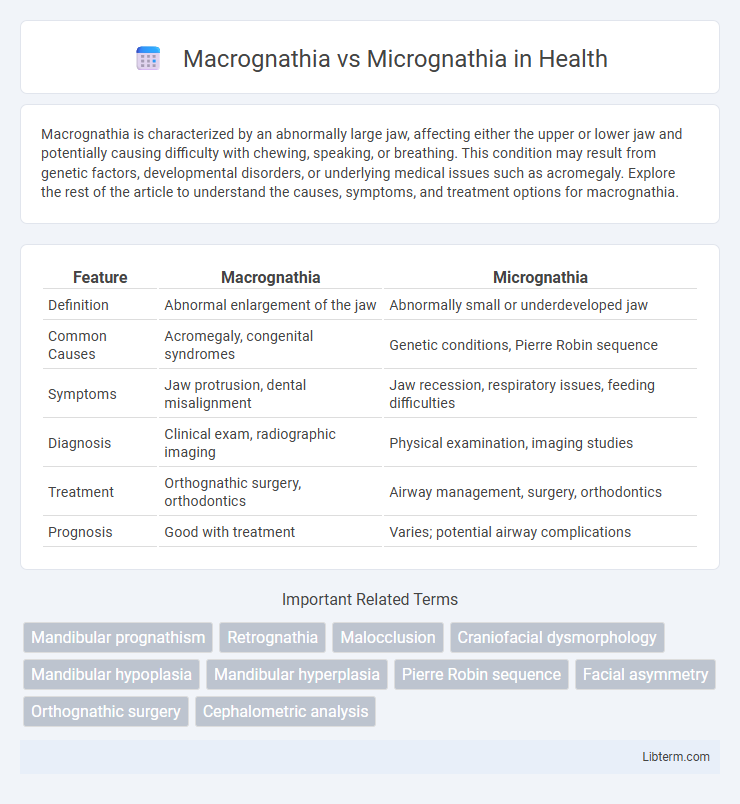Macrognathia is characterized by an abnormally large jaw, affecting either the upper or lower jaw and potentially causing difficulty with chewing, speaking, or breathing. This condition may result from genetic factors, developmental disorders, or underlying medical issues such as acromegaly. Explore the rest of the article to understand the causes, symptoms, and treatment options for macrognathia.
Table of Comparison
| Feature | Macrognathia | Micrognathia |
|---|---|---|
| Definition | Abnormal enlargement of the jaw | Abnormally small or underdeveloped jaw |
| Common Causes | Acromegaly, congenital syndromes | Genetic conditions, Pierre Robin sequence |
| Symptoms | Jaw protrusion, dental misalignment | Jaw recession, respiratory issues, feeding difficulties |
| Diagnosis | Clinical exam, radiographic imaging | Physical examination, imaging studies |
| Treatment | Orthognathic surgery, orthodontics | Airway management, surgery, orthodontics |
| Prognosis | Good with treatment | Varies; potential airway complications |
Introduction to Jaw Abnormalities
Macrognathia and micrognathia are distinct jaw abnormalities characterized by excessive or insufficient jawbone growth, respectively. Macrognathia involves an enlarged mandible or maxilla, often causing facial asymmetry and dental malocclusion, while micrognathia presents as a disproportionately small jaw, leading to airway obstruction and feeding difficulties. Accurate diagnosis through clinical evaluation and imaging is essential for effective management of these developmental conditions.
Defining Macrognathia and Micrognathia
Macrognathia is characterized by an abnormally large jaw, often causing facial asymmetry and dental misalignment, while micrognathia refers to an unusually small jaw, frequently associated with airway obstruction and difficulty in feeding. Both conditions affect mandibular size but differ significantly in clinical presentation and underlying etiology, impacting diagnosis and treatment approaches. Precise measurement of jaw dimensions using cephalometric analysis aids in distinguishing macrognathia from micrognathia for appropriate orthodontic or surgical intervention.
Key Differences Between Macrognathia and Micrognathia
Macrognathia is characterized by an abnormally large jaw, often leading to facial asymmetry, while micrognathia refers to an undersized jaw, which can cause airway obstruction and feeding difficulties. The primary difference lies in jaw size and its impact on function: macrognathia can result in malocclusion due to jaw protrusion, whereas micrognathia frequently causes crowding of tongue and respiratory challenges. Both conditions require distinct diagnostic approaches and treatments tailored to jaw morphology and associated complications.
Causes and Risk Factors
Macrognathia is primarily caused by genetic disorders such as acromegaly and gigantism, leading to excessive growth of the jawbone, while trauma and certain tumors can also contribute. Micrognathia often results from congenital conditions like Pierre Robin sequence, Treacher Collins syndrome, and fetal alcohol syndrome, causing underdevelopment of the lower jaw. Risk factors for both conditions include family history of craniofacial abnormalities, prenatal exposure to teratogens, and chromosomal anomalies.
Symptoms and Clinical Manifestations
Macrognathia presents with an abnormally enlarged jaw, causing difficulty in chewing, speech impediments, and facial asymmetry, often visible as a protruding lower or upper jaw. In contrast, micrognathia is characterized by a significantly smaller jaw size, leading to feeding difficulties in infants, airway obstruction, and dental malocclusions. Both conditions may result in compromised oral function and require clinical evaluation for potential syndromic associations.
Diagnostic Procedures and Imaging
Diagnostic procedures for macrognathia and micrognathia primarily include clinical examination and advanced imaging techniques such as cephalometric X-rays, panoramic radiographs, and 3D computed tomography (CT) scans. Cephalometric analysis provides precise measurements of jaw size and alignment, essential for distinguishing between macrognathia (enlarged jaw) and micrognathia (undersized jaw). Magnetic resonance imaging (MRI) may also be utilized to assess soft tissue involvement and craniofacial abnormalities related to these conditions.
Impact on Oral and Facial Function
Macrognathia, characterized by an abnormally large jaw, often leads to malocclusion, difficulties in chewing, and speech impediments due to misalignment of teeth and jaw structures. Micrognathia, a condition where the jaw is underdeveloped or abnormally small, typically results in challenges with airway obstruction, feeding difficulties in infants, and impaired articulation caused by limited mandibular movement. Both conditions can significantly affect facial aesthetics and oral function, necessitating early diagnosis and multidisciplinary treatment to improve quality of life and functional outcomes.
Treatment and Management Options
Treatment for macrognathia often involves orthognathic surgery to correct jaw enlargement and restore facial balance, complemented by orthodontic therapy to align teeth properly. Management of micrognathia typically includes surgical interventions such as mandibular distraction osteogenesis to promote jaw growth, alongside airway support measures in severe cases to prevent respiratory complications. Both conditions benefit from multidisciplinary care involving maxillofacial surgeons, orthodontists, and speech therapists to optimize functional and aesthetic outcomes.
Prognosis and Long-term Outlook
Macrognathia often results from bone overgrowth and may require surgical intervention to correct jaw alignment and improve oral function, with prognosis depending on the underlying cause and treatment timeliness. Micrognathia, commonly linked to genetic syndromes or developmental issues, can pose challenges like airway obstruction and feeding difficulties, necessitating multidisciplinary care for favorable long-term outcomes. Early diagnosis and individualized management plans substantially enhance prognosis and quality of life for both macrognathia and micrognathia patients.
Preventive Strategies and Early Detection
Preventive strategies for macrognathia and micrognathia emphasize prenatal care, genetic counseling, and monitoring risk factors such as maternal diabetes or teratogen exposure. Early detection relies on advanced imaging techniques like ultrasound and MRI during pregnancy, enabling timely diagnosis and intervention planning. Pediatric evaluation shortly after birth is critical to identify airway obstruction or feeding difficulties, facilitating prompt management and improved outcomes.
Macrognathia Infographic

 libterm.com
libterm.com